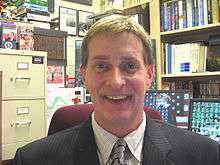James Bidlack

Dr. James Enderby Bidlack (born February 1, 1961) is a Professor of Biology and CURE-STEM Scholar the University of Central Oklahoma, President of Metabolism Foundation.,[1] and Vice President of The Genome Registry. He is a member of the MERLOT Editorial Board MERLOT/Biology,[2] and a past co-sponsor for the Tri-Beta/Biology Club.[3] Most notably, James (Jim) Bidlack is known for his research, textbooks, and involvement with the Repository for Germinal Choice.
Career
Dr. James Enderby Bidlack currently works as a professor of Biology at the University of Central Oklahoma conducting research in multi-disciplinary fields. Bidlack has worked with weed control of pigeon pea.[4] He has performed research to determine the nitrogen content and dry weight of chickpeas as well as pigeon peas in a wheat-legume crop rotation for several years.[4] Some of his most recent work involves measuring the morphology, biomass, and vessel diameter in pigeonpea when being subjected to water stress.[5] He has also worked in collaboration with Philip M. Silverman to evaluate an active type IV secretion system that makes Escherichia coli sensitive to bile salts.[6] Most recently, Dr. Bidlack Co-Founded The Genome Registry with business partner, Hal Stevens.[7]
Published Works
Textbooks
- Bidlack, J.E., and S.H. Jansky. 2014. Introductory Plant Biology, Thirteenth Edition. New York: The McGraw-Hill Companies.
- Bidlack, J.E., and S.H. Jansky. 2011. Introductory Plant Biology, Twelfth Edition. New York: The McGraw-Hill Companies.
- Stern, K.R., J. Bidlack, and S. Jansky. 2008. Introductory Plant Biology, Eleventh Edition. New York: The McGraw-Hill Companies.
- Stern, K.R., J. Bidlack, S. Jansky, and G. Uno. 2006. Introductory Plant Biology, Tenth Edition. New York: The McGraw-Hill Companies.
- Stern, K.R., S. Jansky, and J. Bidlack. 2003. Introductory Plant Biology, Ninth Edition. New York: The McGraw-Hill Companies.
Repository for Germinal Choice
During the mid to late 1990s Bidlack donated specimens to the Repository for Germinal Choice. The Repository for Germinal Choice was a sperm bank which only stocked specimens from those were thought to be the best and the brightest. He was interviewed regarding his involvement with this project by Slate Magazine and the book The Genius Factory: The Curious History of the Nobel Prize Sperm Bank (2005) by David Plotz.[8] Bidlack also appeared in a documentary on the Repository for Germinal Choice, which aired on BBC Horizon in 2006.[9]
References
- ↑ "Officers". Metabolism.net. Retrieved 2013-08-02.
- ↑ "Member Profile". Merlot.org. 1999-12-20. Retrieved 2013-08-02.
- ↑ "Officers & Advisors". Biology.uco.edu. Retrieved 2013-08-02.
- 1 2 Bidlack, James E.; Middick, Andy; Shantz, Delmar; MacKown, Charles T.; Williams, Robert D.; Rao, Srinivas C. (2006). "Weed control in a pigeon pea–wheat cropping system". Field Crops Research. 96: 63. doi:10.1016/j.fcr.2005.05.005.
- ↑ Porter, Monty A.; Bidlack, James E. (2011). "Morphology, Biomass, and Vessel Diameter of Pigeon Pea Subjected to Water Stress". Communications in Soil Science and Plant Analysis. 42 (19): 2334. doi:10.1080/00103624.2011.605491.
- ↑ Bidlack, J. E.; Silverman, P. M. (2004). "An Active Type IV Secretion System Encoded by the F Plasmid Sensitizes Escherichia coli to Bile Salts". Journal of Bacteriology. 186 (16): 5202–9. doi:10.1128/JB.186.16.5202-5209.2004. PMC 490876
 . PMID 15292121.
. PMID 15292121. - ↑ http://www.i-newswire.com/the-genome-registry-making-science/235503
- ↑ Plait, Phil. "The "Genius Babies," and How They Grew - Slate Magazine". Slate.com. Retrieved 2013-08-02.
- ↑ Olding, Paul (2006-06-15). "UK | Magazine | The genius sperm bank". BBC News. Retrieved 2013-08-02.